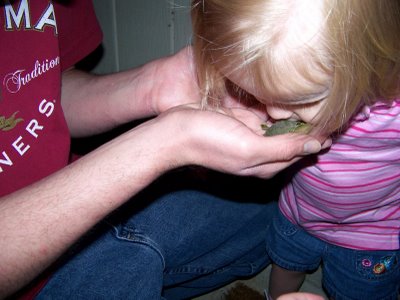At this time of year it’s usually chicks and ducklings and Salmonella, but why not throw some turtles into the mix. Again.
I still regret cuddling up to my pet turtle, but what did I know?
The U.S. Centers for Disease Control reports a total of 66 persons infected with outbreak strains of Salmonella Sandiego, Salmonella Pomona, and Salmonella Poona have been reported from 16 states; 11 ill .jpeg) persons have been hospitalized, and no deaths have been reported; 55% of ill persons are children 10 years of age or younger.
persons have been hospitalized, and no deaths have been reported; 55% of ill persons are children 10 years of age or younger.
Results of the epidemiologic and traceback investigations indicate exposure to turtles or their environments (e.g., water from a turtle habitat) is the cause of this outbreak.
Turtles with a shell length of less than 4 inches in size should not be purchased or given as gifts.
CDC is collaborating with public health officials in multiple states to investigate three overlapping, multistate outbreaks of human Salmonella infections linked to exposure to turtles or their environments (e.g., water from a turtle habitat). The first is an outbreak of human Salmonella Sandiego infections, the second is an outbreak of human Salmonella Pomona infections, and the third is an outbreak of human Salmonella Poona infections. These are rare types of Salmonella.
The Salmonella Sandiego and Salmonella Pomona outbreaks have similar geographic distributions, with cases occurring in the Northeast and Southwest. The Salmonella Poona outbreak has a slightly different geographic distribution, with cases occurring in the Midwest and Southwest. Public health investigators are using the PulseNet system to identify cases of illness that may be part of these outbreaks. In PulseNet, the national subtyping network of public health and food regulatory agency laboratories coordinated by CDC, DNA "fingerprints" of Salmonella bacteria are obtained through diagnostic testing with pulsed-field gel electrophoresis, or PFGE, to identify cases of illness that may be part of this outbreak.
Contact with reptiles (such as turtles, snakes, and lizards) and amphibians (such as frogs and toads) can be a source of human Salmonella infections. Small turtles, with a shell length of less than 4 inches, are a well-known source of human Salmonella infections, especially among young children. Because of this risk, the  Food and Drug Administration (FDA) has banned the sale and distribution of these turtles since 1975. Amphibians and reptiles can carry Salmonella germs and still appear healthy and clean. Salmonella germs are shed in their droppings and can easily contaminate their bodies and anything in areas where these animals live. Reptiles and amphibians that live in tanks or aquariums can contaminate the water with germs, which can spread to people.
Food and Drug Administration (FDA) has banned the sale and distribution of these turtles since 1975. Amphibians and reptiles can carry Salmonella germs and still appear healthy and clean. Salmonella germs are shed in their droppings and can easily contaminate their bodies and anything in areas where these animals live. Reptiles and amphibians that live in tanks or aquariums can contaminate the water with germs, which can spread to people.
